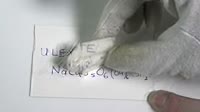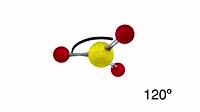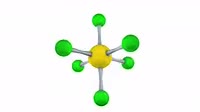Animation of a model of a molecule of ethanol (C2H5OH) showing its polarity. Polarity is a property of a molecule that has an uneven distribution of electric charge around it, giving it two or more poles of opposite charge. Here, red areas have a slight negative charge, blue ones a positive charge. This arises as the oxygen atom (red) has two lone pairs of negative electrons that are not involved in bonding, and also attracts the bonding electrons away from the hydrogen atoms as well. The hydrogen atoms are left with a small positive charge (blue glow). The measure of an atom's ability to attract electrons is called its electronegativity, and is related to the number of protons it has in its nucleus, and the number of electron shells around the nucleus. Polarity plays an important part of determining the properties of a substance. With an asymmetrically-charged molecule like ethanol, the negative part of one molecule can attract and form weak temporary bonds with the positive part of a nearby molecule. At a macroscopic level means the substance has a higher melting and boiling point that may be expected, and a higher viscosity. It also means that the substance can dissolve other polar or charged substances, such as ionic compounds like salt. Compare this molecule with a non-polar molecule such as hexane, in clip K004/4336.
Details
WebID:
C01808273
Clip Type:
RM
Super High Res Size:
1920X1080
Duration:
00:00:10.000
Format:
QuickTime
Bit Rate:
24 fps
Available:
download
Comp:
200X112 (0.00 M)
Model Release:
NO
Property Release
No













 Loading
Loading